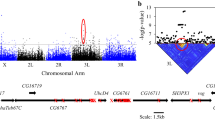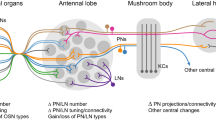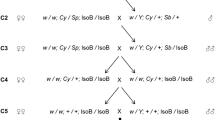Abstract
The existence of genetic variability for olfactory response within natural populations ofDrosophila melanogaster was studied in two newly collected natural populations from two very different habitats, the Sandiche population, from a very heterogeneous environment, and the Los Areneros population, from a very homogeneous one. Intrapopulational variability was estimated over approximately 50 isofemale lines derived from each population. Results confirm significant differences in olfactory response to ethyl alcohol and acetaldehyde in both populations and to ethyl acetate in the Sandiche population. The differences were due partially to common components of the olfactory responses to different chemical (nonspecifics) in the Sandiche population, but they were specific for the stimulus in the Los Areneros population.
Similar content being viewed by others
References
Aceves-Piña, E. O., and Quinn, W. G. (1979). Learning in normal and mutantDrosophila larvae.Science 206:93–95.
Alcorta, E., and Rubio, J. (1988). Genetical analysis of intrapopulational variation in olfactory response inDrosophila melanogaster.Heredity 60:7–14.
Bartelt, R. J., Schaner, A. M., and Jackson, L. L. (1985). Cis-vaccenyl acetate as an aggregation pheromone inDrosophila melanogaster.J. Chem. Ecol. 11:1747–1756.
Barrows, W. M. (1907). The reactions of the pomace flyDrosophila ampelophila Loew, to odorous substances.J. Exp. Zool. 4:515–537.
Becker, H. J. (1970). The genetics of chemotaxis inDrosophila melanogaster. Selection for repellent insensitivity.Mol. Gen. Genet. 107:194–200.
Begg, M., and Hogben, L. (1946). Chemoreceptivity ofDrosophila melanogaster.Proc. Roy. Soc. Lond. Ser. B 133:1–19.
Fuyama, Y. (1976). Behavior genetics of olfactory responses inDrosophila. I. Olfactometry and strain differences inDrosophila melanogaster.Behav. Genet. 6:407–420.
Fuyama, Y. (1978). Behavior genetics of olfactory responses inDrosophila. II. An odorantspecific variant in a natural population ofDrosophila melanogaster.Behav. Genet. 8:399–414.
Hoffmann, A. A. (1983). Bidirectional selection for olfactory response to acetaldehyde and ethanol inDrosophila melanogaster.Genet. Sel. Evol. 15:501–518.
Hoffmann, A. A., Parsons, P. A., and Nielsen, K. M. (1984). Habitat selection: Olfactory response ofDrosophila melanogaster depends on resources.Heredity 53:139–143.
Kaissling, K. E. (1971). Insect olfaction. In Beidler, L. M. (ed.),Handbook of Sensory Physiology, Vol. 4(I), Springer-Verlag, New York.
Kikuchi, T. (1973). Specificity and molecular features of an insect attractant in aDrosophila mutant.Nature 247:36–38.
Médioni, J. (1968). Premières donnés sur le rythme journalier de l'activité locomotrice chezDrosophila melanogaster (Dipt. Drosophilidae).Ann. Epiphyties 19:193–194.
Parsons, P. A. (1973).Behavioral and Ecological Genetics: A Study in Drosophila, Clarendom Press, Oxford.
Parsons, P. A. (1979). Polygenic variation in natural populations ofDrosophila. In Thompson, J. J., Jr., and Thoday, M. J. (eds.),Quantitative Genetic Variation, Academic Press, New York.
Parsons, P. A. (1980). Larval responses to environmental ethanol inDrosophila melanogaster: Variation within and among populations.Behav. Genet. 2:183–190.
Reed, M. R. (1938). The olfactory reactions ofDrosophila melanogaster Meigen to the products of fermenting banana.Physiol. Zool. 11:317–325.
Rodrigues, V. (1980). Olfactory behavior ofDrosophila melanogaster. In Siddiqi, O., Babu, P., Hall, L. M., and Hall, J. C. (eds.),Development and Neurobiology of Drosophila, Plenum Press, New York.
Rodrigues, V., and Siddiqi, O. (1978). Genetic analysis of chemosensory pathway.Proc. Ind. Sci. 87B:147–160.
Siddiqi, P. (1987). Neurogenetics of olfaction inDrosophila melanogaster.TIG 3:137–142.
Siegel, S. (1979).Estadística no Paramétrica Aplicada a las Ciencias de la Conducta. Trillas, México.
Snedecor, G. W., and Cochran, W. G. (1971).Métodos Estadísticos, CECSA, México.
Spieth, H. T. (1974). Courtship behavior inDrosophila.Annu. Rev. Entomol. 19:385–405.
West, A. S. (1961). Chemical attractants for adultDrosophila species.J. Econ. Entomol. 54:677–681.
Author information
Authors and Affiliations
Rights and permissions
About this article
Cite this article
Alcorta, E., Rubio, J. Intrapopulational variation of olfactory responses inDrosophila melanogaster . Behav Genet 19, 285–299 (1989). https://doi.org/10.1007/BF01065911
Received:
Accepted:
Issue Date:
DOI: https://doi.org/10.1007/BF01065911




